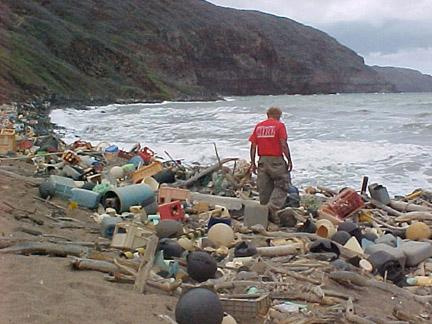
If you do one thing for the environment in 2015, it could be to help clean up and prevent plastic trash from polluting our oceans. More than 5 trillion pieces of plastic may be floating—and sinking deeper—in the world's oceans, according to scientists. This marine debris includes toys, toothbrushes, bottles, plastic bags, fishing nets and other items that break down into smaller pieces and are carried around the globe by ocean currents and waves.
Planning a marine cleanup for Earth Day 45 (April 22), World Oceans Day (June 8), or any day in 2015? Add STEM exploration to your environmental efforts with the Howtosmile.org activity A Scientific Cleanup. This is a comprehensive lesson plan for a cleanup trip to a local beach, lake or stream. Learners keep track of and analyze the types and amounts of trash they pick up (including plastic), discuss the marine debris problem in their community, and consider ways to prevent pollution. The lesson helps learners understand the effects of both natural events and human influences on ecosystems. It also teaches them science process skills like forming questions and answering them by experimenting, carrying out research, and designing experimental tests.
Ocean pollution gets really hands-on in the All Tangled Up activity. Learners examine and simulate wildlife entanglement by experiencing what it might be like to be a marine animal trapped in debris. Learners wrap rubber bands around their fingers and across the back of their hands, then try to disentangle themselves.
You can use easy to find images of stuff—or actual stuff—that humans add to ocean or beach pollution in the I Am/Who Has: A Litter Matching Game activity. Learners can discover the source of ocean debris like cans, plastic grocery bags, tires, plastic food wrappers, and water bottles, and how to reduce their use or prevent them from ending up in the ocean.

Drawing what they learn about marine debris can help reinforce students' understanding of ocean pollution and its environmental impact. Have learners look at thirteen winning student illustrations from NOAA's 2014 "Keep the Sea Free of Debris" Art Contest. Then encourage them to create their own marine debris themed art for their classroom, home, afterschool program, or even a future art contest.
Younger learners can also do fun games and puzzles from NOAA's downloadable Understanding Marine Debris booklet. Older learners can check out the new book Plastic Ahoy: Investigating the Great Pacific Garbage Patch, by Patricia Newman with photos by Annie Crawley. The book follows a scientific expedition out into the ocean to study the effects of plastic pollution, answer questions about what happens when plastic ends up where it doesn't belong, and explore how it affects ocean life.
